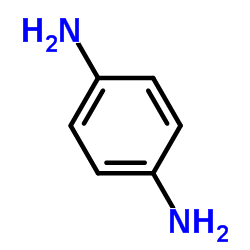p-Phenylenediamine

p-Phenylenediamine structure
|
Common Name | p-Phenylenediamine | ||
|---|---|---|---|---|
| CAS Number | 106-50-3 | Molecular Weight | 108.141 | |
| Density | 1.2±0.1 g/cm3 | Boiling Point | 267.4±13.0 °C at 760 mmHg | |
| Molecular Formula | C6H8N2 | Melting Point | 139 °C | |
| MSDS | Chinese USA | Flash Point | 135.9±19.3 °C | |
| Symbol |



GHS06, GHS08, GHS09 |
Signal Word | Danger | |
|
HIV-1 and its gp120 inhibits the influenza A(H1N1)pdm09 life cycle in an IFITM3-dependent fashion.
PLoS ONE 9(6) , e101056, (2014) HIV-1-infected patients co-infected with A(H1N1)pdm09 surprisingly presented benign clinical outcome. The knowledge that HIV-1 changes the host homeostatic equilibrium, which may favor the patient resistance to some co-pathogens, prompted us to investigate wh... |
|
|
Novosphingobium aquaticum sp. nov., isolated from lake water in Suwon, Republic of Korea.
Antonie van Leeuwenhoek 108 , 851-8, (2015) A novel Gram-stain negative, yellow coloured, strictly aerobic, rod-shaped, non-motile bacterium designated as THW-SA1(T), was isolated from lake water near Samsung apartment, Suwon, Republic of Korea. The phylogenetic analysis based on 16S rRNA gene sequence... |
|
|
Pedobacter edaphicus sp. nov. isolated from forest soil in South Korea.
Arch. Microbiol. 197 , 781-7, (2015) A Gram-negative, yellow-colored, rod-shaped, strictly aerobic, motile bacterium was isolated from forest soil in Gyeongsang Province, South Korea. The strain was designated as THG-DA2.1(T). Cells of strain THG-DA2.1(T) grew optimally at pH 7.0, at temperature... |
|
|
Abbreviated exposure to hypoxia is sufficient to induce CNS dysmyelination, modulate spinal motor neuron composition, and impair motor development in neonatal mice.
PLoS ONE 10 , e0128007, (2015) Neonatal white matter injury (nWMI) is an increasingly common cause of cerebral palsy that results predominantly from hypoxic injury to progenitor cells including those of the oligodendrocyte lineage. Existing mouse models of nWMI utilize prolonged periods of... |
|
|
Non-animal photosafety screening for complex cosmetic ingredients with photochemical and photobiochemical assessment tools.
Regul Toxicol Pharmacol 72 , 578-85, (2015) Previously, a non-animal screening approach was proposed for evaluating photosafety of cosmetic ingredients by means of in vitro photochemical and photobiochemical assays; however, complex cosmetic ingredients, such as plant extracts and polymers, could not b... |
|
|
Identification of the toxic trigger in mushroom poisoning.
Nat. Chem. Biol. 5 , 465-7, (2009) We have isolated the small, highly strained carboxylic acid cycloprop-2-ene carboxylic acid from the Asian toxic mushroom Russula subnigricans. This compound is responsible for fatal rhabdomyolysis, a new type of mushroom poisoning that is indicated by an inc... |
|
|
A multicopper oxidase contributes to the copper tolerance of Brucella melitensis 16M.
FEMS Microbiol. Lett. 362 , fnv078, (2015) Copper is a potent antimicrobial agent. Multiple mechanisms of copper tolerance are utilized by some pathogenic bacteria. BMEII0580, which is significantly similar to the multicopper oxidase from Escherichia coli, was predicted to be the probable blue copper ... |
|
|
Transdermal penetration behaviour of drugs: CART-clustering, QSPR and selection of model compounds.
Bioorg. Med. Chem. 15 , 6943-55, (2007) A set of 116 structurally very diverse compounds, mainly drugs, was characterized by 1630 molecular descriptors. The biological property modelled in this study was the transdermal permeability coefficient logK(p). The main objective was to find a limited set ... |
|
|
Identification of 12/15-lipoxygenase as a regulator of axon degeneration through high-content screening.
J. Neurosci. 35(7) , 2927-41, (2015) Axon degeneration is a programed process that takes place during development, in response to neuronal injury, and as a component of neurodegenerative disease pathology, yet the molecular mechanisms that drive this process remain poorly defined. In this study,... |
|
|
Neurodegeneration and Vision Loss after Mild Blunt Trauma in the C57Bl/6 and DBA/2J Mouse.
PLoS ONE 10 , e0131921, (2015) Damage to the eye from blast exposure can occur as a result of the overpressure air-wave (primary injury), flying debris (secondary injury), blunt force trauma (tertiary injury), and/or chemical/thermal burns (quaternary injury). In this study, we investigate... |